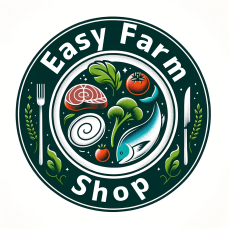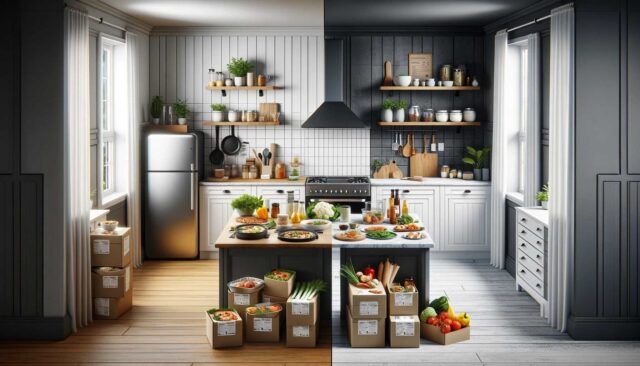Home Delivery Meal Boxes vs. Recipe Boxes
The terms “home delivery meal boxes” and “home delivery recipe boxes” often refer to two different types of food delivery services, each catering to different needs and preferences. Here’s a breakdown of their differences:
Home Delivery Meal Boxes
- Prepared Meals: These boxes typically contain meals that are already cooked and prepared. Customers simply need to heat them before eating.
- Convenience: Ideal for those with busy schedules who don’t have time to cook. They offer the utmost convenience as minimal to no preparation is required.
- Limited Customization: The meals are chef-designed and pre-made, so there’s limited scope for customization or altering the ingredients.
- Nutrition and Variety: These services often cater to a range of dietary preferences and needs, but customers have less control over the specific ingredients used.
- Shelf Life: Prepared meals usually have a shorter shelf life and require refrigeration.
Home Delivery Recipe Boxes
- Ingredients and Recipes: These boxes provide all the necessary ingredients in pre-measured quantities along with detailed recipes for customers to cook meals at home.
- Cooking Experience: They cater to those who enjoy cooking but want to avoid the hassle of meal planning and grocery shopping.
- Customization and Flexibility: There’s more flexibility to tweak recipes according to personal preferences or dietary restrictions.
- Educational Aspect: They offer the opportunity to learn new cooking skills and recipes.
- Shelf Life and Storage: Ingredients typically have a longer shelf life than prepared meals, as they are raw and need to be cooked.
In summary, home delivery meal boxes are about convenience and saving time, providing fully prepared meals, whereas home delivery recipe boxes are about the experience and joy of cooking, offering the ingredients and recipes for home cooking. The choice between the two depends on individual preferences, lifestyle, and the amount of time and effort one is willing to invest in meal preparation.
Home Delivery Meal Boxes vs. Recipe Boxes: Sustainability and Ethics
Determining whether home delivery meal boxes or recipe boxes are more ethical and sustainable involves examining several factors. Both can be designed with sustainability and ethics in mind, but their impact in these areas can differ based on their operational models.
Home Delivery Meal Boxes (Prepared Meals)
Sustainability Pros
- Reduced Food Waste: Pre-portioned meals can help in reducing food waste as customers receive only what they will consume.
- Efficient Logistics: Centralized cooking and packaging might lead to more efficient logistics, potentially lowering the carbon footprint associated with delivery.
Sustainability Cons
- Packaging Waste: Prepared meals often require significant packaging to maintain food safety and freshness, which can lead to more waste unless eco-friendly materials are used.
- Energy Usage in Preparation: The energy used in mass cooking facilities can be substantial, depending on the source of energy and efficiency of the operations.
Ethical Considerations
Labor practices in preparation facilities and the supply chain’s treatment of workers are key ethical considerations. Also, the sourcing of ingredients (local, organic, fair trade) plays a role.
Home Delivery Recipe Boxes
Sustainability Pros
- Less Energy for Meal Preparation: Since cooking is done by the customer, the overall energy use for meal preparation may be lower compared to centralized mass cooking.
- Potential for Sustainable Sourcing: There’s an opportunity for these services to source ingredients sustainably, supporting local farms and organic produce.
Sustainability Cons
- Packaging for Individual Ingredients: While there’s less need for preserving prepared meals, the individual packaging of each ingredient can contribute to waste.
- Carbon Footprint of Delivery: Delivering raw ingredients can sometimes require more frequent deliveries compared to prepared meals, potentially increasing the carbon footprint.
Ethical Considerations
Similar to meal boxes, the ethics of labor practices and ingredient sourcing are crucial. There’s also the educational aspect of promoting cooking skills and healthier eating habits.
Which is Better in Terms of Ethics and Sustainability?
Neither type is inherently “better” in terms of ethics and sustainability; it largely depends on the specific practices of the provider. Key factors include:
- Source of Ingredients: Are they locally sourced, organic, or sustainably produced?
- Packaging: Is it recyclable, compostable, or minimized?
- Delivery Logistics: Are they optimized for minimal environmental impact?
- Company Practices: Does the company engage in fair labor practices and contribute positively to the community?
Consumers should evaluate each service based on these criteria. A service that excels in sustainable sourcing, minimal and eco-friendly packaging, efficient delivery, and ethical labor practices, whether it’s a meal box or a recipe box, would be considered more sustainable and ethical. The decision also depends on the consumer’s values, whether they prioritize local sourcing, minimal packaging, or the reduction of food waste.

